Razer
Razer Blade 15: hot ahead!
Aprox. 1399€ - see price -
See specificationsFirst known for its garish peripherals, Razer has been trying the IT adventure for some time now with expensive but well-finished PCs. The new flagship model of the Californian brand, the Blade 15, focuses as much on finesse as on power.
Our review
Presentation
With its first Razer Blade, the brand has moved out of its comfort zone and has succeeded in offering products that can be improved, but have their own personality. Same thing with the recent Razer Phone. Since then, Razer has taken the bottle and offers a whole range of PCs, gaming or not.
With the Razer Blade 15.6, the manufacturer has chosen to offer a war machine equipped with a GTX 1070 Max-Q Design in a 1.7 cm chassis. An objective fulfilled, the PC keeping all its promises at stake. Nevertheless, the slimming cure of Razer ends up being paid for, the Blade 15.6 emitting a heat as unpleasant as disturbing in play.
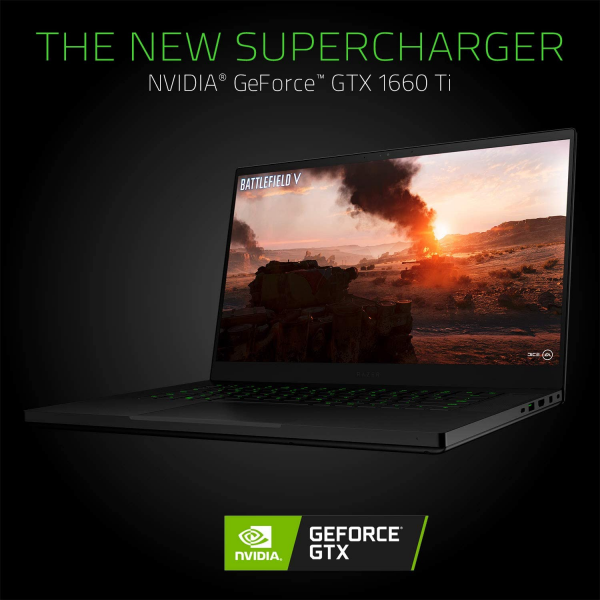
Construction
If there is one thing Razer sticks to on his PCs and smartphones, it is his visual identity. For this Blade, we find the chassis as sober as it is angular in black aluminum which characterizes the range. Always a visually flawless finish. To mark its gaming aspect, the PC has just a backlit Razer logo on its cover, nothing more when it is closed.
A design that is changing in the PC landscape for gamers where the escalation of ostentatious grids and LEDs is common. The grilles, precisely, are placed under the PC and at the back of the chassis in order to be as discreet as possible. A more visual choice than practical - we will come back to this.
Once opened, the PC reveals a keyboard similar to that of previous models. RGB, the keyboard can be managed via the Razer Synapse software, preinstalled on the PC. To gain finesse, Razer has chosen to shorten the stroke of its chiclet keyboard as much as possible, which ultimately does not make typing very pleasant. The trackpad is responsive and pleasant to use, which is rare on a gaming laptop.
Connectivity is content with the minimum for a gaming PC. The Razer Blade 15 has a proprietary power outlet, a USB Type-C port, three USB 3.0 ports, a mini-DisplayPort port and an HDMI port, in addition to the traditional headphone port.
It is at the time of examining the heat of the PC with the thermal camera that the Blade reveals its Achilles heel. Indeed, during our usual protocol (Metro Last Light benchmark for one hour), it reaches the maximum temperature of 62 ° C at the rear grille. It's a lot. Likewise, aluminum reaches 54 ° C above the keyboard; it is impossible to place fingers without getting burned. Even worse, the heat is diffused slowly through the chassis, which makes it unpleasant to put your wrist on it in the playing position. Uncontrolled heating, which is done for the benefit of an amazing silence, the PC not exceeding the 45 dB at stake. So bad for good.
Side consumption, the Blade remains in the current average with a consumption of 40 watts on the desk, 155 watts in play and 0 watt in standby.
In short, a PC in the main lines of Razer's machines, but which this time preferred to sacrifice freshness on the altar of heating, and not vice versa.
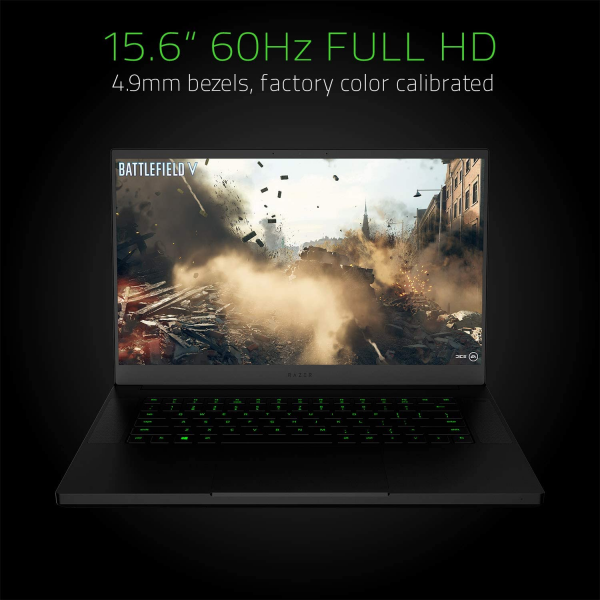
Screen
The 15.6 inch Razer Blade has a 15.6 inch screen with a resolution of 1920 x 1080 px. Razer is betting on two things to extol the merits of its screen: the refresh rate of 144 Hz as well as the ultra-thin edges. The screen-to-face ratio is thus 82.7%, making it the gaming PC with the thinnest edges. It sits right in front of the Aero 15X V8 with its 80.5% ratio.
Scrutinized by our probe, the screen of the Razer Blade 15 reveals correct results, but far from being exceptional. The contrast is thus only 900: 1, a fairly low score which does not allow a good vision of the gray details and which is handicapping in dark games, for example. The temperature is 6,950 K, a correct score relatively close to the 6,500 K reference, a sign of the perfect white balance.
The Razer's screen is distinguished above all by its Delta E which displays an excellent average of 2.2 confirmed by the color table. Thus, the colors delivered by the screen are extremely faithful. The remanence is also excellent, since it is 5 ms. A pleasure in play.
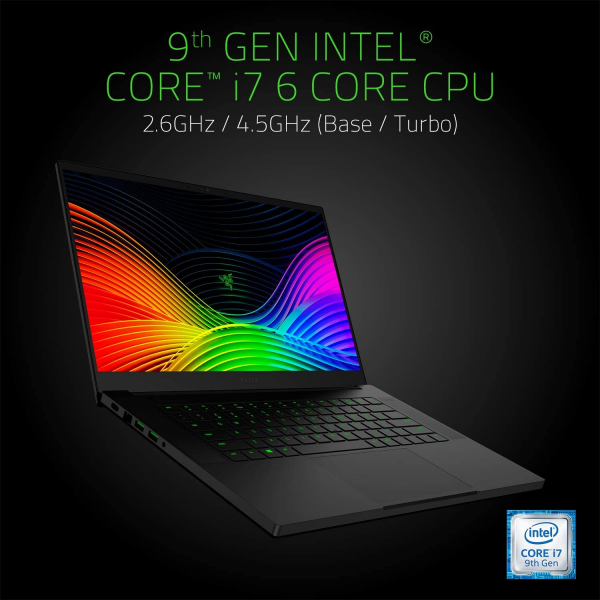
Performances
The Razer Blade 15 is equipped with an Intel Core i7-8750H processor supported by 16 GB of RAM. Powerful equipment that should not limit the user.
During our usual test protocol (photo, video, audio compression), the Razer Blade showed its muscles and reached the index of 158 on our scale. It ranks among the best PCs tested by us. Only the MSI GT75 Titan 8 RF, equipped with an Intel Core i9, surpasses it. With such power, the user will have plenty of time to push the PC to its limits and run applications that are very greedy in computing.
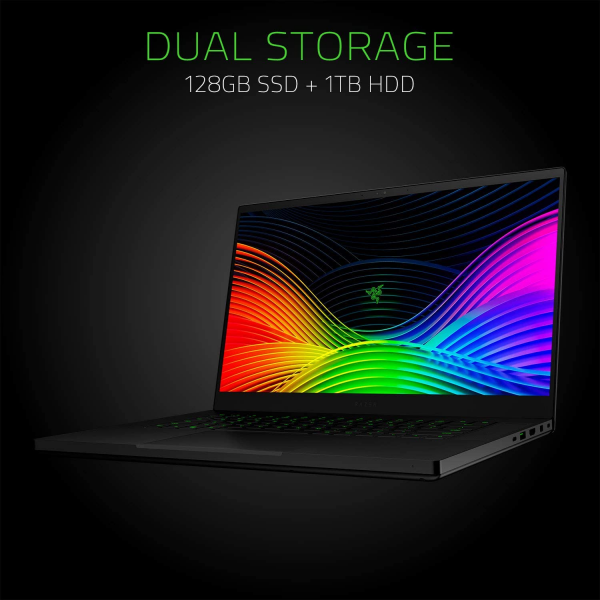
Games
The Razer Blade 15 is equipped with an Nvidia GTX 1070 Max-Q card (but it also exists with a 1060 or a 1050, both Max-Q). It therefore seeks to offer in an ultra-thin chassis a really interesting power in play.
During our usual tests (setting in Ultra, vertical synchronization disabled and definition in 1080p), the PC did not fail. Assassin's Creed Origins reached 57 fps, The Witcher 3 82 fps, Civilization 6 75 fps, Star Wars Battlefront 2 94 fps and Metro Last Light 102 fps. The user therefore does not have to worry about the power of his gaming machine and can run all the big softs of the moment in Ultra mode without asking questions.
In terms of pure power, the Razer Blade still shows the limits of the Max-Q Design. It falls short of other equivalent models like the Aero 15 X V8, which is better ventilated. A difference which however is not felt in play.
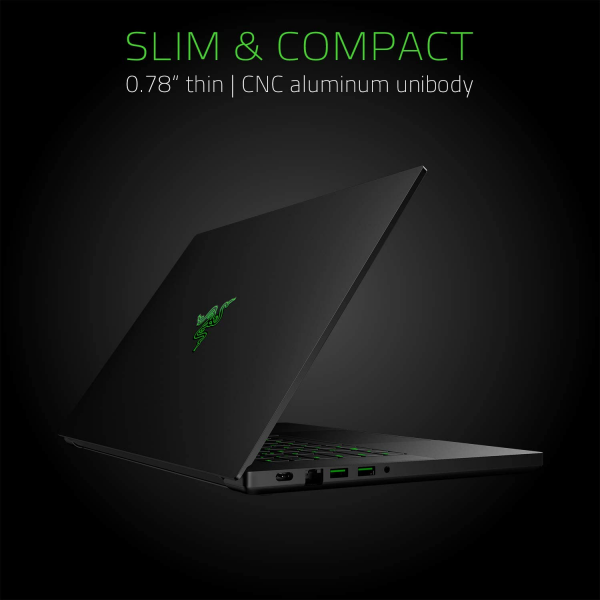
Mobility / Autonomy
Weighing 2 kg, the Razer Blade is relatively light for a gaming PC. Similarly, its thickness of 1.68 cm almost places it in the category of ultraportables and allows it to be easily transported in a bag. Unfortunately, the power supply, of normal size for a gaming model, comes a little to clutter the congestion. Likewise, the catastrophic autonomy counterbalances this design which relies on lightness and finesse.
Thus, during our usual test (Netflix in Chrome, brightness set to 200 cd / m², headphones plugged in), it went out after 2 hours and 12 minutes. Even for a model for players, it is very little. A disappointing and surprising figure, so much so that we did a second test session to be sure of this result, without seeing any improvement. The user will therefore constantly have to keep his PC plugged in and will not even be able to watch a long film on his Razer Blade 15. A big disappointment.
Update: Following the remark of a reader in comment of the test, we carried out a second autonomy test, but this time adjusting the screen to 60 hertz. The screen of the Razer is by default in 144 hertz and you have to delve into the options to deactivate this feature. Once removed, autonomy improves significantly since it increases to 6 hours and 20 minutes. Always low autonomy, but more in line with other gaming PCs on the market. Surprisingly, other computers equipped with a 144 hertz screen (like the Aero 15 X from Gigabyte) do not know this glaring difference in autonomy when it is deactivated. An anomaly that deserves to be reported. In all cases, you will have to deactivate the functionality in the options to watch series or movies on your Razer Blade. Consequently, the score in the autonomy section has been raised
Audio
With its speakers placed around the keyboard, the Razer Blade delivers a bland sound, correct in the mids, but without bass or treble. Add to that an unpleasant compression to the ear as well as too high a distortion, and here is a PC with a sound worthy of a radio. However, voices have the merit of being intelligible, an asset for the game.
The headphone jack is very correct, delivering good results. We note a very high power and excellent dynamics.
Conclusion
With its attractive looks (a successful design, an impressive finesse ...), the Razer Blade 15.6 however fails to offer an experience worthy of its price. If he succeeds in being powerful, the heating is however too annoying to be ignored. If the screen is under control, the default poor autonomy does not allow you to enjoy it without moving away from a socket. In short, Razer still has a little work to succeed, namely to offer an ultra-powerful PC in an ultra-portable chassis.
Specifications
Reviews

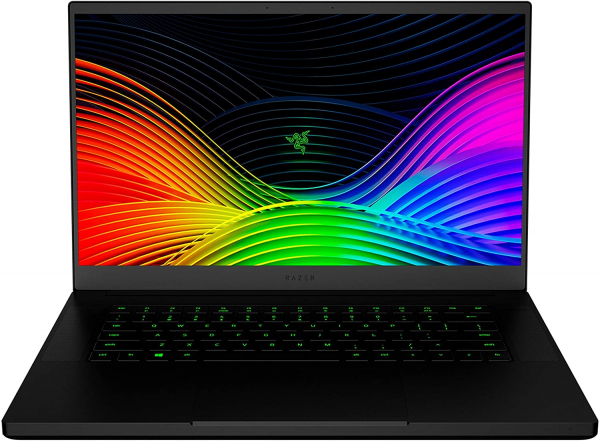
Almost perfect but too many compromises!
Amazing build quality! I got the base model with 2060 / 512gb. The 512gb drive that comes with it is fast but off brand. I put in a Samsung 970 Pro which I highly recommend! Upgrading is super easy as Razer put everything on top when you take off the bottom. My MSI GS63 was a nightmare! Razer was very thoughtful in the upgrade department! Installing Linux was a breeze, I installed KDE Neon and everything worked out of the box! Very very happy with this laptop!
** UPDATE 7/20/19 **
So after a couple of weeks with the Razer Blade 15 (Mid 2019) Base Model, I am not so thrilled! The thermals are not very good and the fan noise is horrible! The fans will just crank up out of nowhere with one app open! I am returning this laptop, just to many compromises for such an expensive device!
The best? The best.
After way too much research and weighing pros and cons, I finally decided to pull the trigger on the 15 "Blade Base model (with ethernet) with GTX 1660Ti. I needed something that would be overkill as a desktop replacement in the field. This is it.
Purpose: I work as a sound mixer in film production and occasionally we have musical elements that require a serious workstation. I needed a powerhouse for multi-tracking Pro Tools. I occasionally game on it, I'd say about 20% of the time, but primarily this is for sound / audio tasking in a professional environment.
Pros:
- specs. I love a laptop that can crush most desktops.
- brilliant screen. Awesome colors, great contrast, and of course 144hz is mandatory for gaming. I can't use 60hz anymore, even for daily office duties, I can see the flicker now, and it fatigues me.
- build quality is superb. It looks fantastic, feels exceptionally well made, definitely puts MacPro aesthetic and "quality" to shame. Also, durability is expected to be top notch. When I'm shopping for new equipment, if it's on demo in a store, I'll go in and do drop tests; spike it into the counter, slam it around, bend the screen, mistreat it, pound the keyboard, hit the trackpad, etc. Out of everything, this felt the best. No creaking of the chassis when you pick it up at a corner, no flex when you push on the case, none of that BS.
- performance is incredible. I've never seen it hiccup or stall on anything, even when recording 5-6 tracks in ProTools with dozens of CPU-intensive plugins running. I loaded up some massive sessions (80+ tracks) with plugins on every slot, and it still wasn't even trying. Now I'll even do quick edits to sessions instead of firing up the desktop rig. I don't play Call of Dooty MW, but all the other modern and less modern games I threw at it were a cakewalk.
- ports. it has the perfect combination. I have the Base model (w / ethernet), and along with the USB-C port, there's really no reason why you can't match any desktop rig in terms of connectivity. I plugged in my Satechi USB-C breakout, and everything worked simultaneously.
- aesthetic. I have to say it again, it looks phenomenal.
Cons:
(these are VERY pessimistic, like if I was in a horrible mood and someone forced me to say negative things)
- despite the screen being incredible, there is * some * light bleed at the corners (3 of 4, to be exact). I understand this to be a big flaw for some people, but I don't play visually dark games. Even when watching a dark scene in a movie, I can't tell. It's only on bootup when the screen is 99.99% black. Occasionally when Photoshopping I'll notice it, but again, it's very very minor in the overall perspective of having other colors / things on the screen.
- keyboard takes getting used to. after 2 days it felt natural, but it's not the easiest learning curve. I have a mechanical keyboard on my desktop with Cherry Browns, so the contrast couldn't be more extreme, but I can flip flop between the two with no problem now. Also, per other peoples' comments, the arrows are definitely misplaced; they need to be moved one button / column over to the right, or swapped with the shift key.
- battery life is pretty bad. But, this IS a gaming machine / desktop replacement. With screen brightness cranked and playing an intensive game, I can barely make it over 2 hours. Day to day office use with screen brightness set moderately, I can pull maybe 4-5 hours. It does recharge quickly, however.
- fans. they're definitely there. this would be a legit negative trait. If you're in a bone quiet room doing emails and youtube, you'll barely hear them. But, if you're gaming, they get pretty loud. For the performance, this is a small caveat.
- lid logo, this is the only other real "negative" quality for me. In a professional setting, I can't have it glowing, as much as I personally do love it. I skinned it with the matte black cover from SopiGuard. Still looks awesome.
Again, I just want to reiterate these cons are subtle at their worst. I wanted to give a thorough breakdown of the bad qualities, as mild as they are.
Overall: If you can afford it, do it. Get the 4-year warranty through Amazon (Asurion) so you have nothing to lose. I turn on the desktop rig significantly less now, when it's so easy to reach for the Blade and get work done. I'm not a brainless Razer fanatic by any means, but I have to admit, this is the best option out there right now, and I'm becoming a fan.
Its a gaming laptop
There's a lot of mixed reviews out there for this thing. Yes, it does getting warmish / hot ... its a gaming laptop ... you can't have crazy specs, be super thin, light, and expect the computer to stay cool with the amount of space to regulate the time. Same thing goes for the fans, of course they're gonna kick in while you're playing ... you put stress on all the performing parts, so the fan's RPMs need to increase in order to keep the parts cool. For battery, I think it's sufficient, you shouldn't be playing AAA games on ultra settings not plugged in anyways. Just browsing the internet on battery savings mode you'll hit around 6 hours on a full battery, which is enough for me. The build quality is top notch, track pad is amazing, looks awesome, no regrets. The only thing I wish this laptop had was the ability for 64GB of RAM (only 32, the advanced model has the capabilities of 64GB), but I wanted an ethernet port more, so it was a trade off. Overall, I'm glad I purchased it.
So much potential, lacking execution
After looking at Razer for replacing my desktop with a decent gaming laptop, I had high hopes for this one. Well, I've been underwhelmed and disappointed. It functions great as a laptop alone. Nice screen, great keyboard layout and overall speed is wonderful. It fails at the core purpose though, gaming. I've had nothing but problems running games in mid-level graphics settings. After a short while, it get "micro stuttering" and significant heat on the keyboard. The former has been repaired once by Razer, but reappeared after I received it back (waiting on the next repair approval ...). The latter was reported as "normal" by Razer. Both the system (keyboard and hinge area) and the power brick itself get extremely hot after 30 minutes of use. The power brick concerns me that it either sits on a desk or on the floor. The heat levels worry me that I'll end up burning an outline into wherever it is sitting.
Razer support has been mediocre. Mostly generic "try updating your drivers" or "have you started from scratch" troubleshooting. For the price, I expected much, much more. They do provide prepaid shipping labels for their warranty work, but boxing is up to you. I'm hoping they either resolve my issue or replace the system on the next repair attempt. Shame on me for tossing the box so soon after purchase, otherwise I'd be returning this system and looking elsewhere.
Be wary and read the skeptical reviews.
UDPATE:
Do not buy this laptop. Razer support is abysmal and I'm still waiting for repairs after a month of the original issue with the stuttering.
Sleek and powerful
I needed a work laptop, but also wanted a gaming machine. This is a great mixture of the 2. Very solid build. It doesn't look like a gamer laptop. I needed this so I don't look silly in the office. I have no issues like some of the others.
Note: This is the base model and does not allow per key customization for that RGB stuff. That's lame since it has the capability. It's limited so you spend more for the advanced model. Kinda of a crap move by razor. Dropped rating to 4